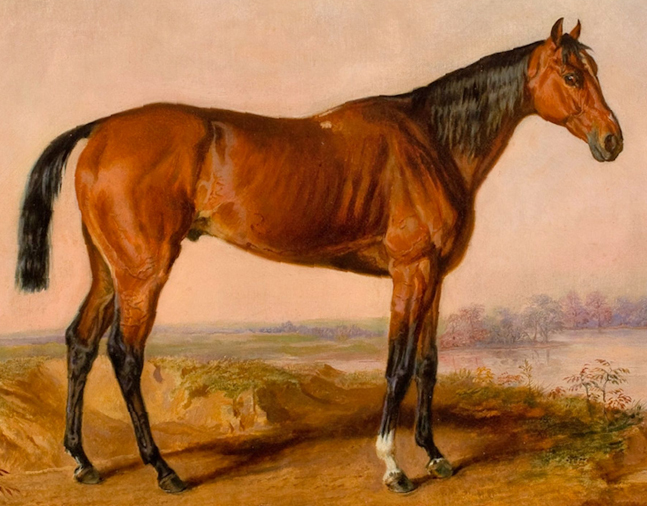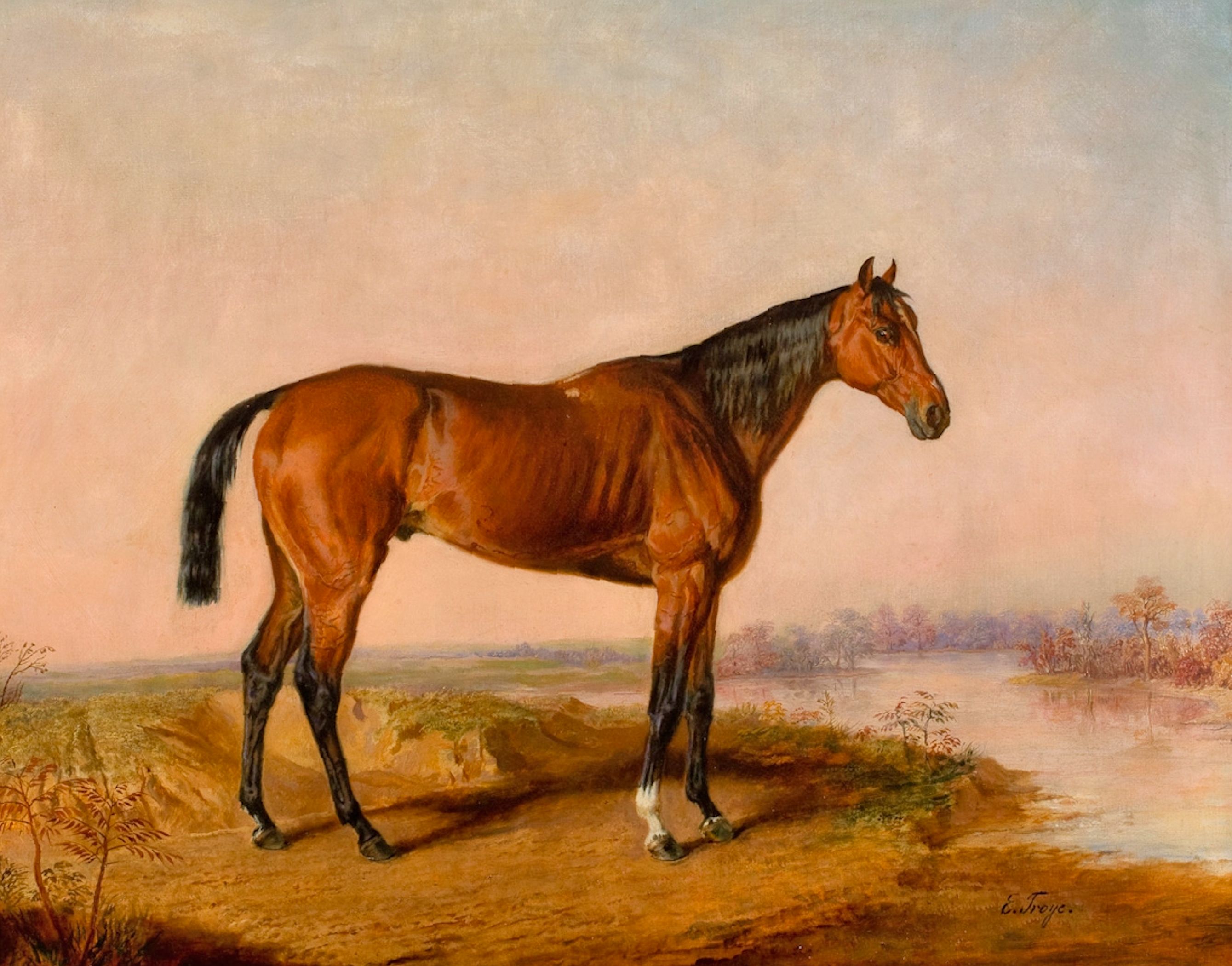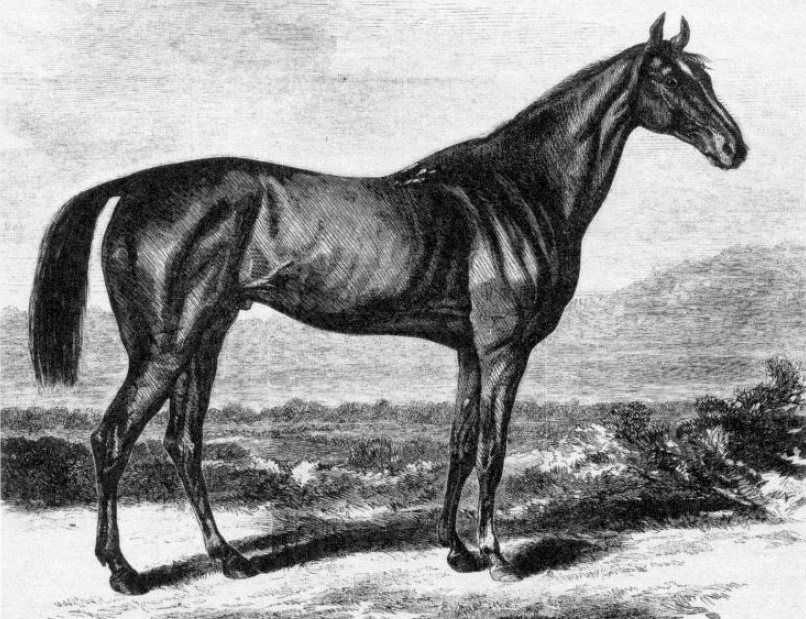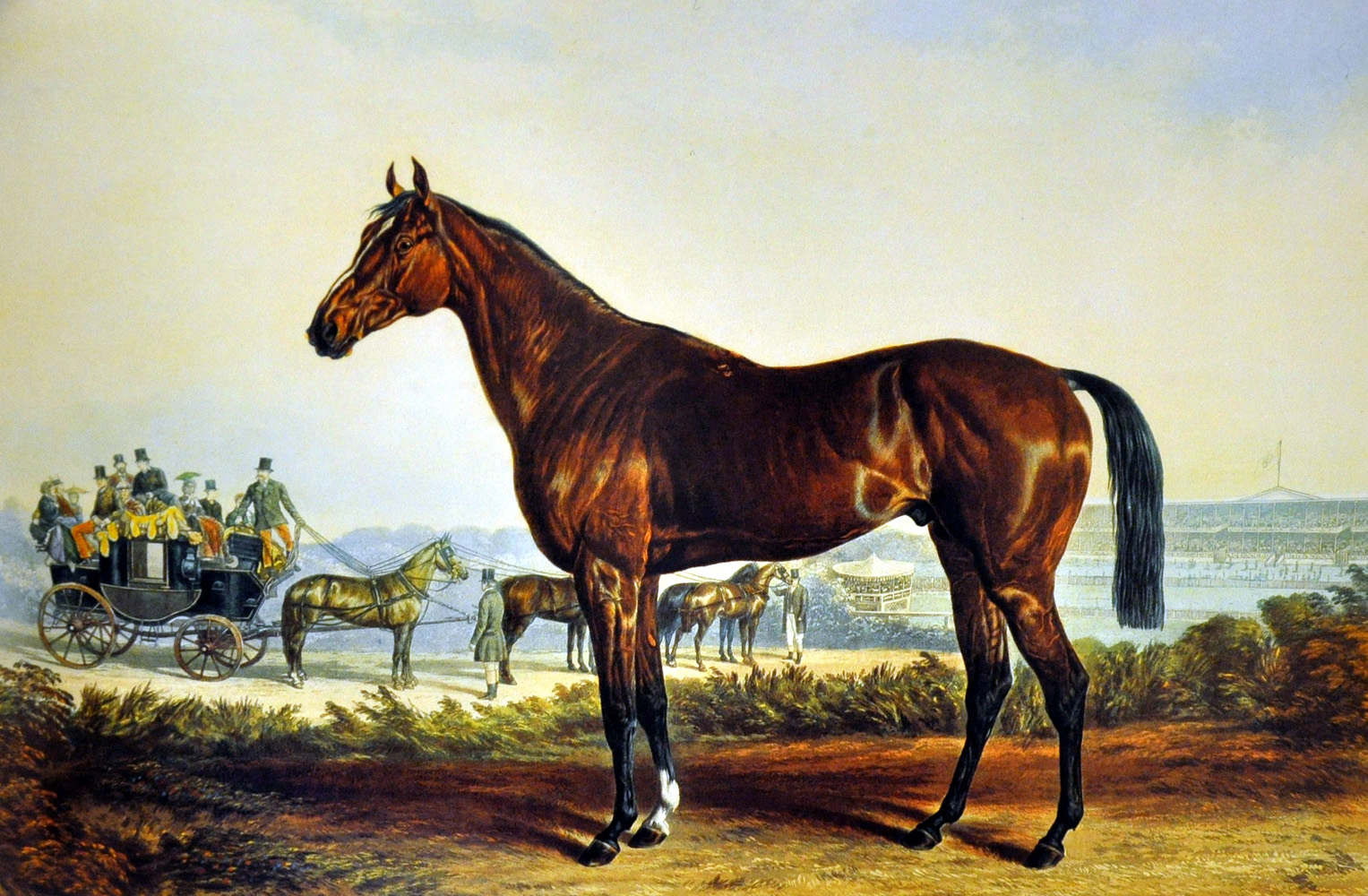Kentucky (KY)
As some of the darkest days of the Civil War brought widespread death and destruction to the South, an equine hero was rising to prominence at the new Saratoga Race Course in upstate New York. Although most things that hailed from the South at the time were regarded with contempt in the North, the remarkable racehorse Kentucky proved to be an exception.

1983
1861
Lexington
Magnolia
Glencoe
John M. Clay
John M. Clay; John Hunter, George Osgood, and William R. Travers; Leonard W. Jerome; August Belmont I
A. J. Minor
1863-1866
$33,700
Racing Record
22
Starts
| 1863 | 1 | 1 | 0 | 0 | $800 $800 |
| 1864 | 7 | 6 | 0 | 0 | $14100 $14,100 |
| 1865 | 7 | 7 | 0 | 0 | $6050 $6,050 |
| 1866 | 7 | 7 | 0 | 0 | $12750 $12,750 |
Biography
As some of the darkest days of the Civil War brought widespread death and destruction to the South, an equine hero was rising to prominence at the new Saratoga Race Course in upstate New York. Although most things that hailed from the South at the time were regarded with contempt in the North, the remarkable racehorse Kentucky proved to be an exception.
In a career that more than a century later earned him a place in the Hall of Fame, Kentucky won 21 of 22 starts — including 20 in a row — and established himself as the first four-legged sensation at Saratoga. In the early days of the Spa’s fabled history, Kentucky won the inaugural Travers Stakes and the first two runnings of the Saratoga Cup, which at the time was considered to be as prestigious as any race in the land.
Bred in Lexington, Kentucky, by John M. Clay at Ashland Stud, Kentucky was an 1861 foal by the mighty sire Lexington out of the Glencoe mare Magnolia. Clay raced Kentucky once as a 2-year-old. At a new track in Paterson, New Jersey, Kentucky broke his maiden at first asking in October 1863.
Following his career debut, Kentucky was sold to John Hunter, who later became the first chairman of The Jockey Club. Hunter brought in William R. Travers and George Osgood as partners in the promising colt. Kentucky was described Walter Vosburgh "as a rangy, bright bay, having an Arab-like head with a narrow stripe down his face and an off-fore white pastern. He was said to have excellent shoulders, a strong, short back and the cleanest and soundest feet, legs, and hocks." Another contemporary report indicated Kentucky had “an easy, graceful stride with truly beautiful and magnificent action.”
Kentucky made his 3-year-old debut in the 1½-mile Jersey Derby at the Paterson course on June 7, 1864, finishing a distant fourth. Accounts of the race said that Kentucky had been interrupted twice in his training for the race and that he was not in top condition. Kentucky never lost again.
Two days after his defeat in the Jersey Derby, Kentucky rebounded to win the two-mile Sequel Stakes and was then shipped to Saratoga. Amid great fanfare, Saratoga Race Course opened its gates for the first time on Aug. 2, 1864. Only a few weeks had passed since more than 7,000 Union soldiers were killed in one of the Civil War’s most gruesome battles at Cold Harbor, Virginia. At Saratoga, however, the bloody battlefields of the South were far from the general consciousness and the talk of the town was thoroughbred racing.
The inaugural Travers Stakes was the first event at the new Saratoga track. The race was named for William R. Travers, one of Kentucky’s three owners and the president of the Saratoga Association. With future Hall of Fame jockey Gilbert W. Patrick in the irons, Kentucky thundered home to win by three lengths. Three days after winning the Travers at 1¾ miles, Kentucky won the two-mile Sequel Stakes at Saratoga, then returned to New Jersey and closed out his campaign with three more victories — all in a five-day span — including the Jersey St. Leger at 2¼ miles.
At ages 4 and 5, Kentucky was the undisputed best horse in America. He won all seven of his races from June through October in 1865, including the first edition of the Saratoga Cup. Two of Kentucky’s victories that season were walkovers as legitimate competition was becoming scarce.
Kentucky followed up his undefeated 4-year-old season with another perfect campaign at age 5 in 1866. On June 6, at Paterson, Kentucky defeated Norwich at two-mile heats. The next day, he won a three-mile race in 6:04¼. A day after that he won at three-mile heats. Following the grueling stretch of running 13 miles in three days, the iron horse Kentucky was rested until Saratoga opened.
Back at the Spa, Kentucky rolled to his second consecutive Saratoga Cup victory. He then went four miles in a walkover four days later at Saratoga in preparation for Jerome Park’s Inaugural Stakes, which he had no trouble winning in consecutive four-mile heats.
Leonard Jerome, who built Jerome Park, was so impressed with Kentucky that he made his owners an offer they could not refuse. Jerome purchased Kentucky for $40,000, an unprecedented price for a racehorse at the time. Kentucky didn’t disappoint his new owner, romping in the Grand National Handicap at 2¾ miles while giving anywhere from 19 to 24 pounds to his opponents. His win streak was at 20. There was nothing left for Kentucky to prove.
Following the Grand National, Jerome decided it was time to retire Kentucky to stud. However, more than two years after his final race — and well into his stud career — Kentucky returned to the racetrack for a run against the clock. Kentucky’s sire, Lexington, had set the world record for four miles at 7:19¾ a dozen years earlier. Jerome bet $5,000 that Kentucky could break the mark.
Three miles into his race against time at Jerome Park in October 1868, Kentucky was at 5:29 flat, two seconds faster than his sire at the same point in the journey. Kentucky had Charles Littlefield aboard for the daunting time trial and was carrying 120 pounds. Lexington, meanwhile, carried only 103 pounds when he set the record. In the final mile, Kentucky began to wear down. Frustrated and starting to sulk, he tried to bolt the course and his final time of 7:31¾ was 12 seconds slower than Lexington’s. It was still regarded as a heroic effort considering the amount of time Kentucky had been away from the track.
Following the time trial, Kentucky was purchased by August Belmont I for $15,000 and sent to Belmont’s Nursery Stud at Babylon, New York, on the south shore of Long Island. Kentucky never approached Lexington’s greatness as a stallion, but he did sire a few notable runners, including Woodbine, winner of the Alabama Stakes and Monmouth Oaks, and Jersey Derby winner Bertram. Kentucky died at age 14 in 1875.
Media







